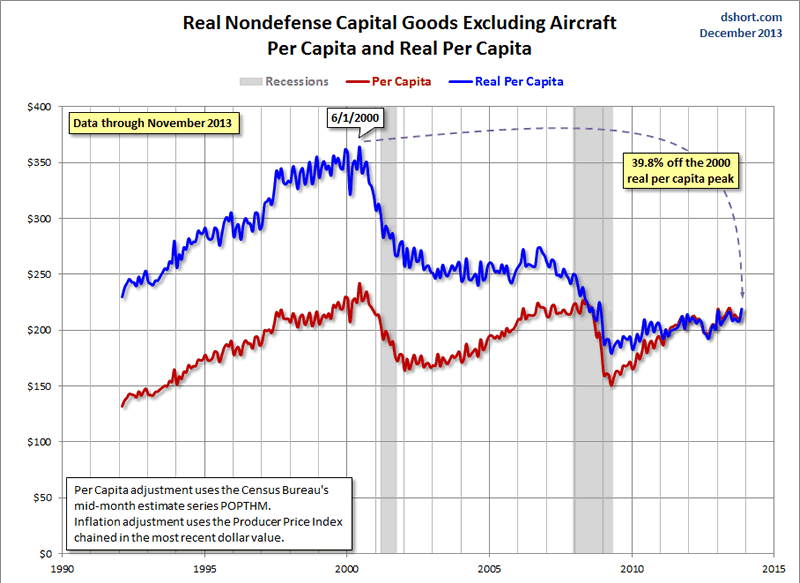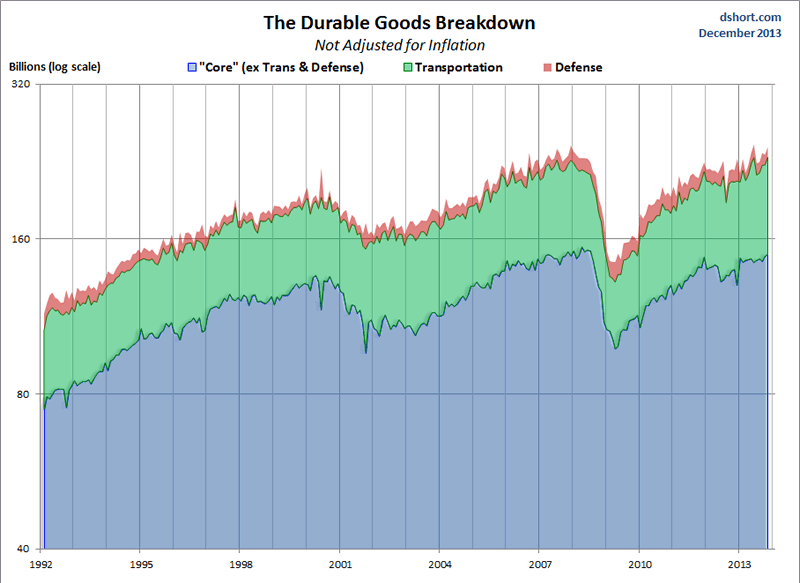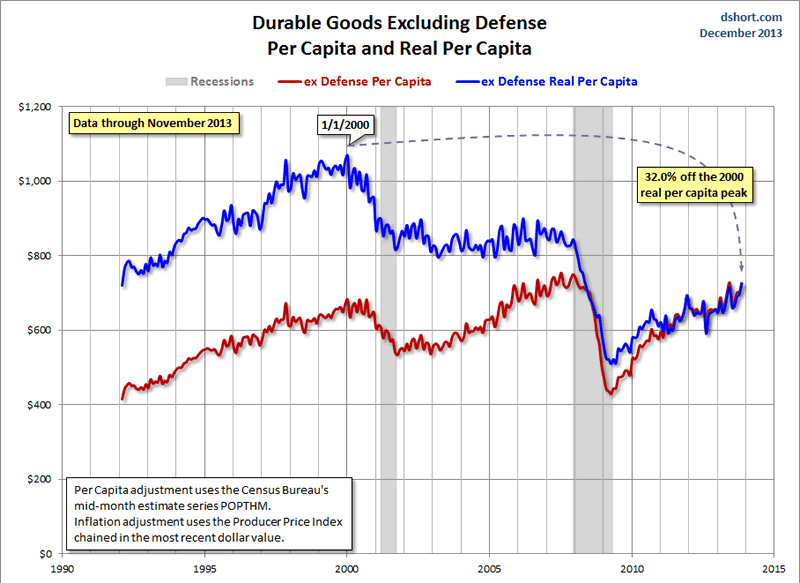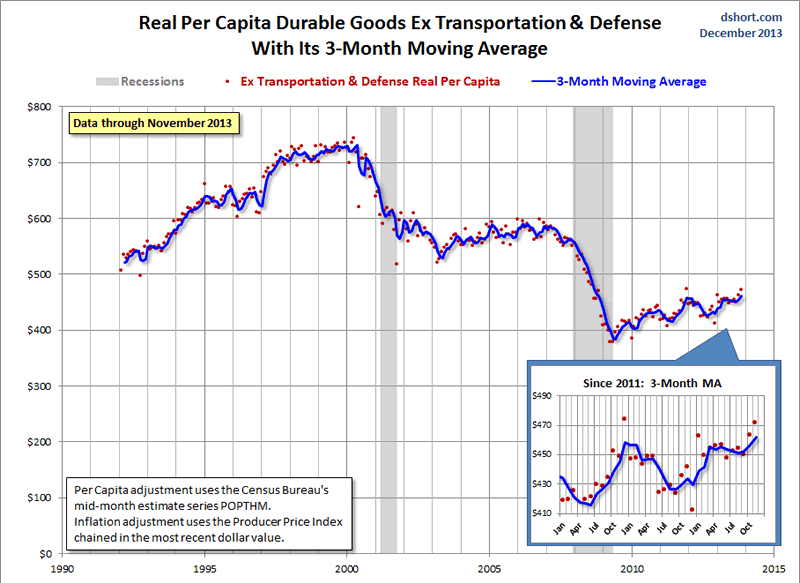U.S. Economy - The ‘Real’ Goods on the Latest Durable Goods Data
Economics / US Economy Dec 25, 2013 - 04:59 PM GMTBy: PhilStockWorld
 Earlier today I posted an update on the December Advance Report on November Durable Goods Orders. This Census Bureau series dates from 1992 and is not adjusted for either population growth or inflation.
Earlier today I posted an update on the December Advance Report on November Durable Goods Orders. This Census Bureau series dates from 1992 and is not adjusted for either population growth or inflation.
Let’s now review the same data with two adjustments. In the charts below the red line shows the goods orders divided by the Census Bureau’s monthly population data, giving us durable goods orders per capita. The blue line goes a step further and adjusts for inflation based on the Producer Price Index, chained in today’s dollar value. This gives us the “real” durable goods orders per capita. The snapshots below offer an alternate historical context in which to evaluate the standard reports on the nominal monthly data.

Economists frequently study this indicator excluding Transportation or Defense or both. Just how big are these two subcomponents? Here is a stacked area chart to illustrate the relative sizes over time based on the nominal data.

Here is the first chart, repeated this time ex Transportation, the series usually referred to as “core” durable goods.

Now we’ll leave Transportation in the series and exclude Defense orders.

And now we’ll exclude both Transportation and Defense for a better look at a more concentrated “core” durable goods orders.

Here is the chart that I believe gives the most accurate view of what Consumer Durable Goods Orders is telling us about the long-term economic trend. The three-month moving average of the real (inflation-adjusted) core series (ex transportation and defense) per capita helps us filter out the noise of volatility to see the big picture.

The Trend in Capital Goods
Finally, let’s take a big step back in the sales chain and look at the most popular durable goods data series according to the FRED statistics. It is Nondefense Capital Goods Excluding Aircraft (capital goods being goods that are used in the production of goods or services), shown here on a per-capita basis, nominal and real.

The Long-Term Trend
As these charts illustrate, when we study durable goods orders in the larger context of population growth and also adjust for inflation, the data becomes a coincident macro-indicator of a major shift in demand within the U.S. economy. It correlates with a decline in real household incomes, as illustrated in my analysis of the most recent Census Bureau household income data:
Monthly Median Incomes Since 2000
By Quintile and Top Five Percent
Median Incomes by Age Bracket
Deflating the American Dream
The secular trend in durable goods orders also helps us understand the long-term trend in GDP that I’ve illustrated elsewhere. See especially the most recent update on GDP.
As we can see from the various metrics above, revisions notwithstanding, the real per-capita demand for durable goods had increased since the trough at the end of the last recession. But orders remain far below their respective peaks near the turn of the century and earlier. A key driver, or lack thereof, for healthy growth in durable goods orders is growth in household incomes. For a perspective on this point, see my latest update on Median Household Incomes, data through last month, which are down substantially since the end of the Great Recession.
See also this pair of commentaries focusing on the Sentier Research report on the fourth anniversary of median household incomes since the end of the Great Recession:
Median Household Incomes: The Real Truth About the U.S. Economic Recovery, Four Years Later
Median Household Incomes After the Great Recession: Household Types and Educational Attainment
The next durable goods update from the Census Bureau will be released on January 28th.
- Phil
Philip R. Davis is a founder of Phil's Stock World (www.philstockworld.com), a stock and options trading site that teaches the art of options trading to newcomers and devises advanced strategies for expert traders. Mr. Davis is a serial entrepreneur, having founded software company Accu-Title, a real estate title insurance software solution, and is also the President of the Delphi Consulting Corp., an M&A consulting firm that helps large and small companies obtain funding and close deals. He was also the founder of Accu-Search, a property data corporation that was sold to DataTrace in 2004 and Personality Plus, a precursor to eHarmony.com. Phil was a former editor of a UMass/Amherst humor magazine and it shows in his writing -- which is filled with colorful commentary along with very specific ideas on stock option purchases (Phil rarely holds actual stocks). Visit: Phil's Stock World (www.philstockworld.com)
© 2013 Copyright PhilStockWorld - All Rights Reserved Disclaimer: The above is a matter of opinion provided for general information purposes only and is not intended as investment advice. Information and analysis above are derived from sources and utilising methods believed to be reliable, but we cannot accept responsibility for any losses you may incur as a result of this analysis. Individuals should consult with their personal financial advisors.
PhilStockWorld Archive |
© 2005-2022 http://www.MarketOracle.co.uk - The Market Oracle is a FREE Daily Financial Markets Analysis & Forecasting online publication.



